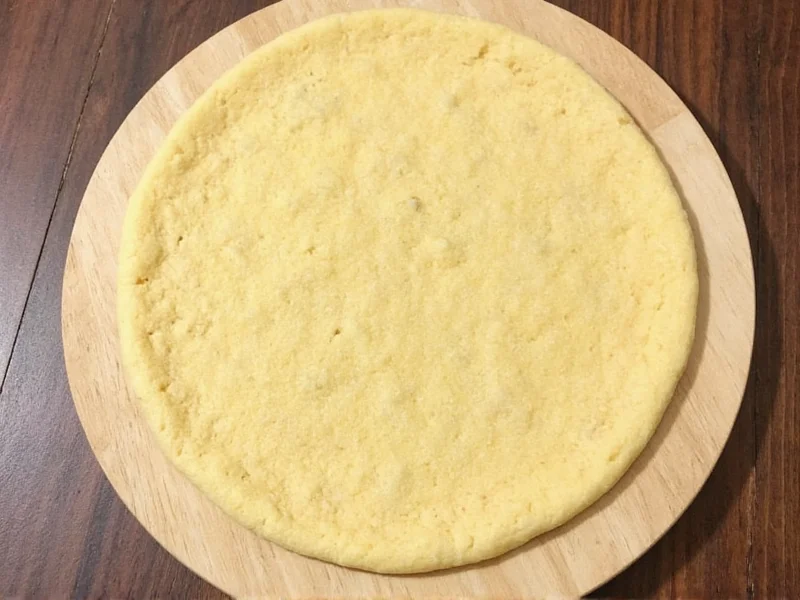Creating the perfect cornmeal pizza crust requires understanding how cornmeal transforms traditional dough. Unlike standard pizza bases, cornmeal crust offers superior crispness and a delicate nutty flavor that complements both classic and creative toppings. The secret lies in cornmeal's ability to absorb moisture while creating microscopic air pockets during baking, resulting in that coveted crunch without dryness.
Why Cornmeal Makes Superior Pizza Crust
Cornmeal's coarse texture serves multiple functions in pizza dough. When incorporated at the right ratio, it creates tiny channels that allow steam to escape during baking, preventing a soggy center. The natural sugars in cornmeal also caramelize faster than wheat flour, producing that beautiful golden-brown color and subtle sweetness that enhances savory toppings. Professional pizzaiolos often dust pizza stones with cornmeal specifically for these textural benefits.
Essential Ingredients for Perfect Cornmeal Crust
| Ingredient | Measurement | Key Function |
|---|---|---|
| All-purpose flour | 2½ cups (315g) | Provides gluten structure for elasticity |
| Yellow cornmeal | 1 cup (140g) | Creates crisp texture and golden color |
| Active dry yeast | 2¼ tsp (7g) | Leavening agent for proper rise |
| Warm water | 1¼ cups (300ml) | Activates yeast and hydrates flour |
| Olive oil | 2 tbsp | Enhances flavor and tenderizes crust |
| Salt | 1½ tsp | Strengthens gluten and balances sweetness |
| Honey | 1 tsp | Feeds yeast and promotes browning |
Step-by-Step Cornmeal Pizza Crust Preparation
- Bloom the yeast: Combine warm water (105-110°F), honey, and yeast in a bowl. Wait 5-7 minutes until foamy.
- Mix dry ingredients: Whisk together flour, cornmeal, and salt in a separate large bowl.
- Combine: Pour yeast mixture and olive oil into dry ingredients. Stir until a shaggy dough forms.
- Knead: Turn onto floured surface and knead 8-10 minutes until smooth and elastic. The dough should pass the windowpane test.
- First rise: Place in oiled bowl, cover, and let rise at room temperature for 1-1½ hours until doubled.
- Shape: Punch down dough, divide if making multiple pizzas, and roll out on cornmeal-dusted surface to desired thickness.
- Second rise: Transfer to cornmeal-dusted pizza peel or pan. Let rest 15 minutes while preheating oven to 475°F with pizza stone inside.
- Bake: Slide pizza onto hot stone and bake 12-15 minutes until golden and crisp.
Pro Tips for Crispy Cornmeal Crust Success
- Use fine-ground cornmeal for better integration with flour. Medium or coarse cornmeal creates excessive crunch.
- Preheat your pizza stone for at least 45 minutes to ensure proper bottom crispness.
- Dust your pizza peel generously with cornmeal to prevent sticking during transfer.
- Avoid overloading with sauce - cornmeal crust absorbs more moisture than traditional dough.
- Brush crust edges with olive oil before baking for extra golden color.
Delicious Variations to Try
Experiment with these easy modifications to customize your cornmeal pizza crust recipe:
- Herb-infused crust: Add 1 tbsp dried rosemary or oregano to dry ingredients
- Whole wheat blend: Substitute 1 cup all-purpose flour with whole wheat flour
- Garlic parmesan crust: Mix 2 tbsp grated parmesan and 1 tsp garlic powder into dry ingredients
- Sweet corn variation: Add 1/4 cup fresh corn kernels to dough for extra texture
Serving and Storage Recommendations
For optimal texture, serve cornmeal pizza immediately after baking. The crust maintains its crispness best when eaten fresh. If you have leftovers, store slices in an airtight container at room temperature for up to 2 days. To reheat, place slices directly on oven rack at 375°F for 5-7 minutes until crisp. Avoid microwaving, which makes the crust soggy. For longer storage, freeze baked crusts (without toppings) for up to 3 months - thaw at room temperature before adding sauce and toppings.
Frequently Asked Questions
Can I make cornmeal pizza crust without yeast?
Yes, you can create a quick version using 2 cups flour, 1 cup cornmeal, 1 tbsp baking powder, 1 tsp salt, 3/4 cup buttermilk, and 2 tbsp olive oil. Mix until a shaggy dough forms, then roll out and bake immediately at 425°F for 10-12 minutes before adding toppings.
Why is my cornmeal crust too crumbly?
Excessive crumbliness usually indicates too much cornmeal or insufficient hydration. Stick to the 1:2½ cornmeal-to-flour ratio and ensure your dough feels slightly tacky but not sticky. Adding 1 extra tablespoon of olive oil can also improve cohesion without compromising crispness.
Does cornmeal crust require different baking time?
Cornmeal crust typically bakes 2-3 minutes faster than regular pizza dough due to cornmeal's quicker browning properties. Watch carefully during the final minutes of baking, as it can go from perfectly golden to overdone rapidly. The ideal internal temperature is 190-200°F.
Can I use polenta instead of cornmeal?
Yes, but note that traditional polenta has a coarser grind than standard cornmeal. For best results, use fine or medium-ground polenta. If using coarse polenta, process it briefly in a food processor to create a finer texture that integrates better with the flour.
What's the best way to prevent cornmeal crust from sticking?
Generously dust your pizza peel or baking surface with additional cornmeal before transferring the shaped dough. For pan pizza, coat the pan with olive oil and sprinkle cornmeal evenly across the bottom. The cornmeal acts as tiny ball bearings, allowing easy movement during transfer.











 浙公网安备
33010002000092号
浙公网安备
33010002000092号 浙B2-20120091-4
浙B2-20120091-4